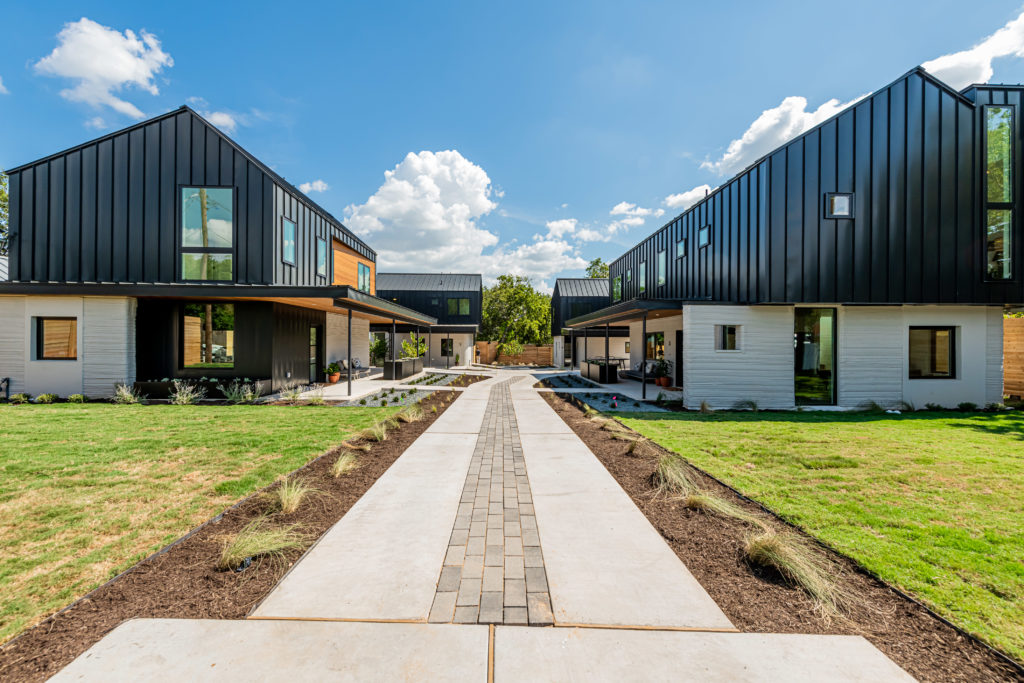Additive construction startup ICON has gone from 3D printing rocket pads to launching like a rocket, recently raking in $207 million in Series B funding. This occurred in the very same month that it unveiled both North America’s largest 3D printed structure and a prototype Mars habitat. Now, as a part of one of the first multi-home housing developments, two more homes have been 3D printed by ICON and they have just hit the market, via Kansas City developer 3Strands and Austin-based Den Property Group.
The East 17th Street Residences development located in East Austin is made up of four homes with first floors that are 3D printed before conventional construction methods are used to complete the second stories. The smaller two of the community measure around 1,000 square feet and feature two bedrooms and one-and-a-half baths.
One of those homes has already been sold and the other is now under contract, leaving ICON to finish the other two, larger units. They consist of the four-bedroom, four-bathroom single-family, dubbed “The Treehouse Residence”, measuring 1,928 square feet and the four-bedroom, three-bathroom Skyview Residence, measuring 1,521 square feet.
3DPrint.com was given an amazing opportunity to do a virtual tour of the new homes. 3Strands CEO Gary O’Dell explained that his firm, established in 2012, turned to ICON in 2018 when it had trouble getting its affordable homes if the ground and began looking for a new approach to developing less expensive houses. When it realized how viable ICON’s additive construction technique was and how professional the team was, they began planning to develop the land 3Strands owned in East Austin.
The first floor was thought up by Logan Architecture and brought into reality using ICON’s Vulcan construction system. According to the company, the material from which the home is made are both stronger and longer lasting than traditional building materials. Moreover, ICON suggests that their 3D printed structures can withstand fire, flood, wind and other natural disasters even more than conventional built homes.
ICON senior project manager Conner Jenkins explained that, to install non-printed features the company is exploring a number of paths. To install electrical outlets, for instance, the firm cut out slots for the box while the concrete is still wet. Electrical wiring can additionally be dropped in from above. For windows, the Vulcan system printed all four sides of the jambs and the frame was inserted after the fact.
Jenkins told us that the reason behind 3D printing just the first floor had to do with the desire to get into the mainstream housing market, though their technology isn’t quite at the level of printing multi-story homes.
“This represents our into the open housing market. It’s an interesting juxtaposition to see more traditional construction literally stacked on top of our process. So, that was part of it,” Jenkins said. “The other part of it was we aren’t printing two stories yet. Our printer can only reach the first story now, but we wanted to jump into the house market with housing that would sell well.”
Based on the response so far, O’Dell believes the new homes will sell well. Comps in the area are closer to $1 million, making the $745,000 and $795,000 homes from 3Strands remarkably less expensive.
With that in mind, O’Dell said, “We think young families with kids or couples without kids will be interested in these. There’s a lot of room. It’s hard to predict, but I think when we sent out our original email, we had something like 800 people sign up to express interest. They were hounding us, ready for the houses to open to the public.”
Austin designer Claire Zinnecker was responsible for the interior finishes and fixtures, relying on a modern West Texas feel, including natural woods, metal finishes and earthy tiles. The result was an interesting juxtaposition of textures and tones, with the layered, grey cement appearing opposite the smooth, white walls. Pops of warm tones were present throughout the house in the form of brown wood cabinets in the bedrooms and red clay tile floors in the bathrooms. Altogether, the printed walls blended seamlessly into a contemporary aesthetic, with the curves and textures reminding visitors that this home was wholly unique.
Concrete is, of course, an overwhelmingly popular material choice for modern homes. Therefore, when it comes to a new technology meant to reduce cost, labor, and ecological footprint, it is important to consider the overall greenhouse gas emissions associated with the material. Around the world, the production of concrete is said to have a carbon footprint behind only that of the U.S. and China.
Jenkins was quick to point out that this large impact represents the industry as a whole, meaning that small startups like his have a marginal effect compared to the construction giants of the world. Nevertheless, he said that the company is aware of the need to develop new, more sustainable options and that, with such a novel business, ICON has the opportunity to take this challenge head-on and reshape the construction industry in more than just building techniques, but in materials as well. For this reason, the startup has a team of engineers working on this problem.
Given the industry excitement around ICON, its team, and the support it has received from such federal divisions as NASA and the Department of Defense, the first 3D printed housing development is just another first for a company that is gaining significant traction in a quickly growing industry. What happens next will surely be just as exciting.
